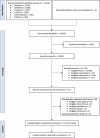Closed-loop oxygen control for critically ill patients--A systematic review and meta-analysis
- PMID: 38865428
- PMCID: PMC11168613
- DOI: 10.1371/journal.pone.0304745
Closed-loop oxygen control for critically ill patients--A systematic review and meta-analysis
Abstract
Background: The impact of closed-loop control systems to titrate oxygen flow in critically ill patients, including their effectiveness, efficacy, workload and safety, remains unclear. This systematic review investigated the utilization of closed-loop oxygen systems for critically ill patients in comparison to manual oxygen titration systems focusing on these topics.
Methods and findings: A search was conducted across several databases including MEDLINE, CENTRAL, EMBASE, LILACS, CINAHL, LOVE, ClinicalTrials.gov, and the World Health Organization on March 3, 2022, with subsequent updates made on June 27, 2023. Evidence databases were searched for randomized clinical parallel or crossover studies investigating closed-loop oxygen control systems for critically ill patients. This systematic review and meta-analysis was performed following the Preferred Reporting Items for Systematic Review and Meta-analysis guidelines. The analysis was conducted using Review Manager software, adopting the mean difference or standardized mean difference with a 95% confidence interval (95% CI) for continuous variables or risk ratio with 95% CI for dichotomous outcomes. The main outcome of interest was the percentage of time spent in the peripheral arterial oxygen saturation target. Secondary outcomes included time for supplemental oxygen weaning, length of stay, mortality, costs, adverse events, and workload of healthcare professional. A total of 37 records from 21 studies were included in this review with a total of 1,577 participants. Compared with manual oxygen titration, closed-loop oxygen control systems increased the percentage of time in the prescribed SpO2 target, mean difference (MD) 25.47; 95% CI 19.7, 30.0], with moderate certainty of evidence. Current evidence also shows that closed-loop oxygen control systems have the potential to reduce the percentage of time with hypoxemia (MD -0.98; 95% CI -1.68, -0.27) and healthcare workload (MD -4.94; 95% CI -7.28, -2.61) with low certainty of evidence.
Conclusion: Closed-loop oxygen control systems increase the percentage of time in the preferred SpO2 targets and may reduce healthcare workload.
Trial registration: PROSPERO: CRD42022306033.
Copyright: © 2024 Mól et al. This is an open access article distributed under the terms of the Creative Commons Attribution License, which permits unrestricted use, distribution, and reproduction in any medium, provided the original author and source are credited.
Conflict of interest statement
MJS was the team leader of Research and New Technologies at Hamilton Medical AG, Bonaduz, Switzerland, from January 2022 until January 2023. The other authors declare no conflicts of interest. This does not alter our adherence to PLOS ONE policies on sharing data and materials. This does not alter our adherence to PLOS ONE policies on sharing data and materials.
Figures





References
-
- O’Driscoll BR, Howard LS, Earis J, Mak V, British Thoracic Society Emergency Oxygen Guideline Group, BTS Emergency Oxygen Guideline Development Group. BTS guideline for oxygen use in adults in healthcare and emergency settings. Thorax [Internet]. 2017;72:ii1–90. Available from: 10.1136/thoraxjnl-2016-209729. - DOI
-
- Petersson J, Glenny RW. Gas exchange and ventilation–perfusion relationships in the lung. Eur Respir J [Internet]. 2014. [cited 2022 Aug 24];44:1023–41. Available from: https://erj.ersjournals.com/content/erj/44/4/1023. doi: 10.1183/09031936.00037014 - DOI - PubMed
-
- de Jonge E, Peelen L, Keijzers PJ, Joore H, de Lange D, van der Voort PHJ, et al.. Association between administered oxygen, arterial partial oxygen pressure and mortality in mechanically ventilated intensive care unit patients. Crit Care [Internet]. 2008;12:R156. Available from: doi: 10.1186/cc7150 - DOI - PMC - PubMed
-
- Barbateskovic M, Schjørring OL, Russo Krauss S, Jakobsen JC, Meyhoff CS, Dahl RM, et al.. Higher versus lower fraction of inspired oxygen or targets of arterial oxygenation for adults admitted to the intensive care unit. Cochrane Database Syst Rev [Internet]. 2019;2019. Available from: doi: 10.1002/14651858.CD012631.pub2 - DOI - PMC - PubMed
Publication types
MeSH terms
Substances
LinkOut - more resources
Full Text Sources
Medical

